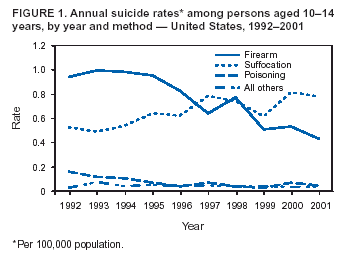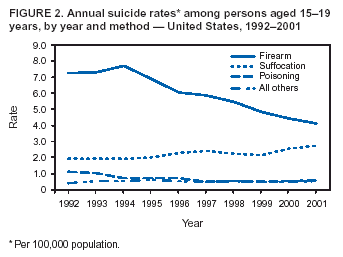 |
|
|
|
|
|
|
| ||||||||||
|
|
|
|
|
|
|
||||
| ||||||||||
|
|
|
|
|
Persons using assistive technology might not be able to fully access information in this file. For assistance, please send e-mail to: mmwrq@cdc.gov. Type 508 Accommodation and the title of the report in the subject line of e-mail. Methods of Suicide Among Persons Aged 10--19 Years --- United States, 1992--2001In 2001, suicide was the third leading cause of death among persons aged 10--19 years (1). The most common method of suicide in this age group was by firearm (49%), followed by suffocation (mostly hanging) (38%) and poisoning (7%) (1). During 1992--2001, although the overall suicide rate among persons aged 10--19 years declined from 6.2 to 4.6 per 100,000 population (1), methods of suicide changed substantially. To characterize trends in suicide methods among persons in this age group, CDC analyzed data for persons living in the United States during 1992--2001. This report summarizes the results of that analysis, which indicated a substantial decline in suicides by firearm and an increase in suicides by suffocation in persons aged 10--14 and 15--19 years. Beginning in 1997, among persons aged 10--14 years, suffocation surpassed firearms as the most common suicide method. The decline in firearm suicides combined with the increase in suicides by suffocation suggests that changes have occurred in suicidal behavior among youths during the preceding decade. Public health officials should develop intervention strategies that address the challenges posed by these changes, including programs that integrate monitoring systems, etiologic research, and comprehensive prevention activities. Annual data on suicides occurring in the United States during 1992--2001 (2) were obtained by using CDC's Web-based Injury Statistics Query and Reporting System (WISQARS™) (1) and examined by age group (i.e., persons aged 10--14 and 15--19 years) and method (e.g., firearm, suffocation, and poisoning) for each year and the 10-year period. To analyze these data, codes were used from the International Classification of Diseases, Ninth Revision (ICD-9) and the International Classification of Diseases and Related Health Problems, Tenth Revision (ICD-10), which was implemented in 1999. Although coding of mortality data changed in 1999, the two revisions have near 100% agreement on classification of suicides by firearm, suffocation, and poisoning (3); thus, the suicide method was defined consistently during the period analyzed. For each method of suicide, annual suicide rates (per 100,000 population) were calculated by age group and overall. Because firearms and suffocation were the two most common methods of suicide among persons aged 10--19 years, accounting for approximately 90% of suicide deaths in this age group, trends for these two methods (Figures 1 and 2) were formally evaluated by using negative binomial rate regression to account for overdispersion in the data. Supplemental information on suicides by poisoning (the third most common method) and suicide by all other methods (e.g., jumping from a height) is provided for illustration purposes. Annual ratios of suffocation suicides to firearm suicides were examined as an additional means of assessing changes in the relative magnitude of these methods over time (Table). Among persons aged 10--14 years, the rate of firearm suicide decreased from 0.9 per 100,000 population in 1992 to 0.4 in 2001, whereas the rate of suffocation suicide increased from 0.5 in 1992 to 0.8 in 2001. Rate regression analyses indicated that, during the study period, firearm suicide rates decreased an average of approximately 8.8% annually (p<0.0001), and suffocation suicide rates increased approximately 5.1% annually (p<0.0001). Among persons aged 15--19 years, the firearm suicide rate declined from 7.3 in 1992 to 4.1 in 2001; the suffocation suicide rate increased from 1.9 to 2.7. Rate regression analyses indicated that, during the study period, the average annual decrease in firearm suicide rates for this age group was approximately 6.8% (p<0.0001), and the average annual increase in suffocation suicide rates was approximately 3.7% (p<0.0001). Poisoning suicide rates also decreased in both age groups, at an average annual rate of 13.4% among persons aged 10--14 years (Figure 1) and 8.0% among persons aged 15--19 years (Figure 2). Because of the small number of suicides by poisoning, these decreases have had minimal impact on changes in the overall profile of suicide methods of youths. Among persons aged 10--14 years, suffocation suicides began occurring with increasing frequency relative to firearm suicides in the early- to mid-1990s, eclipsing (i.e., ratio >1.0) firearm suicides by the late 1990s (Table). In 2001, a total of 1.8 suffocation suicides occurred for every firearm suicide among youths aged 10--14 years. Among youths aged 15--19 years, an increase in the frequency of suffocation suicides relative to firearm suicides began in the mid-1990s; however, in 2001, firearms remained the most common method of suicide in this age group, with a ratio of 0.7 suffocation suicides for every firearm suicide. Reported by: KM Lubell, PhD, MH Swahn, PhD, AE Crosby, MD, Div of Violence Prevention; SR Kegler, PhD, Office of Statistics and Programming, National Center for Injury Prevention and Control, CDC. Editorial Note:The findings in this report indicate that the overall suicide rate for persons aged 10--19 years in the United States declined during 1992--2001 and that substantial changes occurred in the types of suicide methods used among those persons aged 10--14 and 15--19 years. Rates of suicide using firearms and poisoning decreased, whereas suicides by suffocation increased. By the end of the period, suffocation had surpassed firearms to become the most common method of suicide death among persons aged 10--14 years. The reasons for the changes in suicide methods are not fully understood. Increases in suffocation suicides and concomitant decreases in firearm suicides suggest that persons aged 10--19 years are choosing different kinds of suicide methods than in the past. Data regarding how persons choose among various methods of suicide suggest that some persons without ready access to highly lethal methods might choose not to engage in a suicidal act or, if they do engage in suicidal behavior, are more likely to survive their injuries (4). However, certain subsets of suicidal persons might substitute other methods (5). Substitution of methods depends on both the availability of alternatives and their acceptability. Because the means for suffocation (e.g., hanging) are widely available, the escalating use of suffocation as a method of suicide among persons aged 10--19 years implies that the acceptability of suicide by suffocation has increased substantially in this age group. The findings in this report are subject to at least two limitations. First, because U.S. mortality data include a limited number of variables, direct testing of whether method substitution is occurring is not possible; however, no sizeable demographic changes in the composition of youth suicide decedents have been documented that might explain the changes in methods (1). Second, official mortality data for suicide are known to reflect some degree of undercount; however, such undercounts do not appear to affect conclusions about trends over time (6). The findings in this report demonstrate that rapid shifts in youth suicidal behavior can occur, underscoring the need for early effective suicide-prevention efforts that focus on suicidal thoughts and pressures. Moreover, statistical simulations comparing the impacts of different types of suicide-prevention approaches suggest that widely implemented population-based strategies will have a greater effect in reducing overall suicide rates than the more traditional strategies that concentrate on persons at high risk (7). One of the most common population-based strategies focuses on restricting access to highly lethal means (e.g., bridge barriers and bubble-packaging for over-the-counter medications) to diminish the likelihood of death from self-inflicted injuries (8). However, the private nature of suffocation, its widespread availability, and its high lethality suggest that population-based prevention efforts addressing access to lethal means also must confront the underlying reasons for suicidality to avoid the potential for method substitution. Suicide is a multifaceted problem for which several risk factors exist, including societal beliefs regarding the acceptability of suicidal behavior, social isolation and community disintegration, stressful life events, mental illness, and substance abuse (9). When such factors combine with widespread availability of lethal means, higher rates of suicide tend to result (8). The actual effectiveness of existing population-based prevention approaches in reducing the number of suicide deaths is unclear. In addition to improving data-collection methods, public health officials should emphasize the need to evaluate the effectiveness of current suicide-prevention activities and examine how effective strategies can be implemented in diverse communities. CDC supports various efforts to evaluate suicide-prevention programs for youth. Additional information is available at http://www.cdc.gov/ncipc. Acknowledgment The findings in this report are based in part on contributions by JL Annest, PhD, Office of Statistics and Programming, National Center for Injury Prevention and Control, CDC. References
Figure 1  Return to top. Figure 2  Return to top. Table  Return to top.
Disclaimer All MMWR HTML versions of articles are electronic conversions from ASCII text into HTML. This conversion may have resulted in character translation or format errors in the HTML version. Users should not rely on this HTML document, but are referred to the electronic PDF version and/or the original MMWR paper copy for the official text, figures, and tables. An original paper copy of this issue can be obtained from the Superintendent of Documents, U.S. Government Printing Office (GPO), Washington, DC 20402-9371; telephone: (202) 512-1800. Contact GPO for current prices. **Questions or messages regarding errors in formatting should be addressed to mmwrq@cdc.gov.Page converted: 6/9/2004 |
|||||||||
This page last reviewed 6/9/2004
|